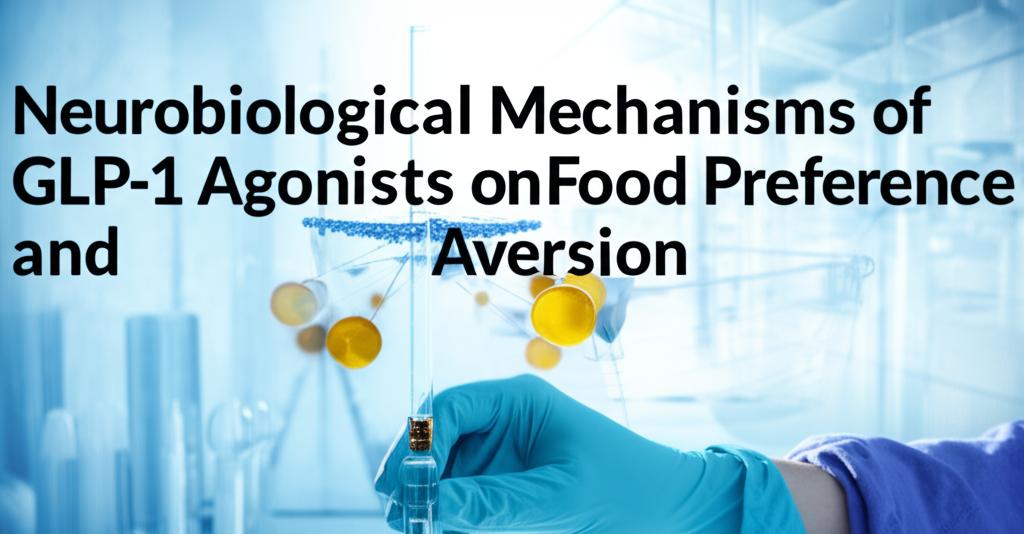Glucagon-like peptide-1 (GLP-1) receptor agonists (GLP-1 RAs) are increasingly recognized for their profound effects on weight loss, extending beyond their initial use in diabetes management. A significant part of their efficacy lies in their ability to modulate food preferences and aversions by acting on various neurobiological pathways. Here's a breakdown of the current understanding:
How GLP-1 Agonists Influence Food-Related Behaviors:- Reduced Appetite and Cravings: GLP-1 RAs are known to decrease overall appetite. Users report feeling less desire for various types of foods, including salty, spicy, high-fat, sweet, and savory options. They also experience fewer cravings for starchy foods and dairy products and find it easier to resist cravings and control their food intake. This is partly due to GLP-1 RAs delaying gastric emptying, which promotes a feeling of fullness.
- Changes in Taste Perception: Recent research suggests that GLP-1 RAs like semaglutide can alter taste sensitivity. Studies have shown that these medications can change gene expression in the tongue related to taste perception and modify the brain's response to sweet tastes. This may explain why individuals using these drugs often report reduced cravings for sugary and energy-dense foods.
- Modulation of Brain Reward Pathways: A key aspect of how GLP-1 RAs work involves their interaction with the brain's reward system.
Mesolimbic System: GLP-1 receptors are found in key areas of the mesolimbic reward circuitry, such as the ventral tegmental area (VTA) and the nucleus accumbens (NAc). Activation of these receptors appears to decrease the rewarding value of palatable foods and the motivation to seek them out.
Amygdala: The central amygdala (CeA) has been identified as a critical node. GLP-1 RAs recruit GLP-1 receptor-expressing neurons in the CeA, which then suppress the consumption of palatable foods by reducing dopamine release in the nucleus accumbens. This pathway seems to be particularly important for curbing reward-driven or "hedonic" feeding.
Reduced Brain Response to Food Cues: Functional magnetic resonance imaging (fMRI) studies have revealed that individuals using GLP-1 RAs show diminished responses to images of food, especially in brain regions associated with reward and appetite, like the amygdala, insula, orbitofrontal cortex, and putamen.
- Action on Hypothalamic and Hindbrain Networks: Beyond the reward circuits, GLP-1 RAs also influence canonical hypothalamic and hindbrain networks that control metabolic homeostasis and satiation.
GLP-1 producing neurons in the nucleus tractus solitarius (NTS) in the brainstem project to various brain regions, including those involved in autonomic function, feeding, and motivation.
The arcuate nucleus (ARC) and paraventricular nucleus (PVN) of the hypothalamus are also key sites of action where GLP-1 RAs can reduce food intake. GLP-1 directly activates POMC/CART neurons (which suppress appetite) and indirectly inhibits NPY/AgRP neurons (which stimulate appetite).
- Gut-Brain Axis Communication: GLP-1 is naturally released by L-cells in the intestine in response to nutrient intake. This gut-derived GLP-1 signals to the brain, including via the vagus nerve and by directly accessing certain brain areas, to promote satiety. GLP-1 RAs mimic and amplify these natural signals. Endogenous GLP-1 released from L-cells can suppress eating via discrete vagal and spinal gut-brain pathways and CNS circuits.
- Aversion: While GLP-1 RAs effectively reduce food intake, they can also induce nausea or aversive responses in some individuals. This aversive property might contribute to reduced food consumption. The central nucleus of the amygdala is implicated in GLP-1-induced aversion. However, research also indicates that GLP-1R activation in some brain regions (like the VTA, NAc, and ventral hippocampus) can reduce food intake without causing nausea. It's suggested that the vagus nerve might mediate some aversive effects of GLP-1.
- Decreased Preference: Studies and user reports indicate a reduced desire for:
High-fat foods
Sweet foods and sugary drinks
Salty foods
Spicy foods
Starchy foods (refined grains)
Dairy products
Processed foods
Beef and sometimes pork
Alcohol
Fruit juice
- Potential Increased Consumption/Preference (or less reduction):
Fruits
Leafy greens
Water
Lean proteins (poultry, fish)
Legumes
* Some animal studies have paradoxically suggested that semaglutide might increase consumption of low- and mid-range sucrose, a finding that needs further investigation in humans.
Mechanisms of Action Summary:GLP-1 agonists exert their effects on food preference and aversion through a complex interplay of actions:
- Direct Brain Action: Many GLP-1 RAs can cross the blood-brain barrier (or act on circumventricular organs that lack a complete barrier) to directly engage GLP-1 receptors in various brain regions.
- Reward Pathway Modulation: They dampen the brain's reward response to highly palatable foods, making them less appealing.
- Homeostatic Pathway Activation: They enhance satiety signals in brain areas that control hunger and fullness.
- Taste Perception Alteration: They may directly change how tastes are perceived.
- Induction of Aversion: For some, a side effect of nausea can contribute to food avoidance.
While the weight-loss effects of GLP-1 RAs are well-established, research continues to unravel the intricacies of their neurobiological mechanisms. Understanding these pathways more thoroughly can help refine treatments, tailor interventions, and potentially develop new therapies for obesity and related disorders, possibly even extending to conditions characterized by dysregulated reward processing, like substance use disorders. Further studies are needed to assess long-term weight maintenance using objective measurements of intake and to fully understand the nuances of how these drugs alter human ingestive behaviors.

